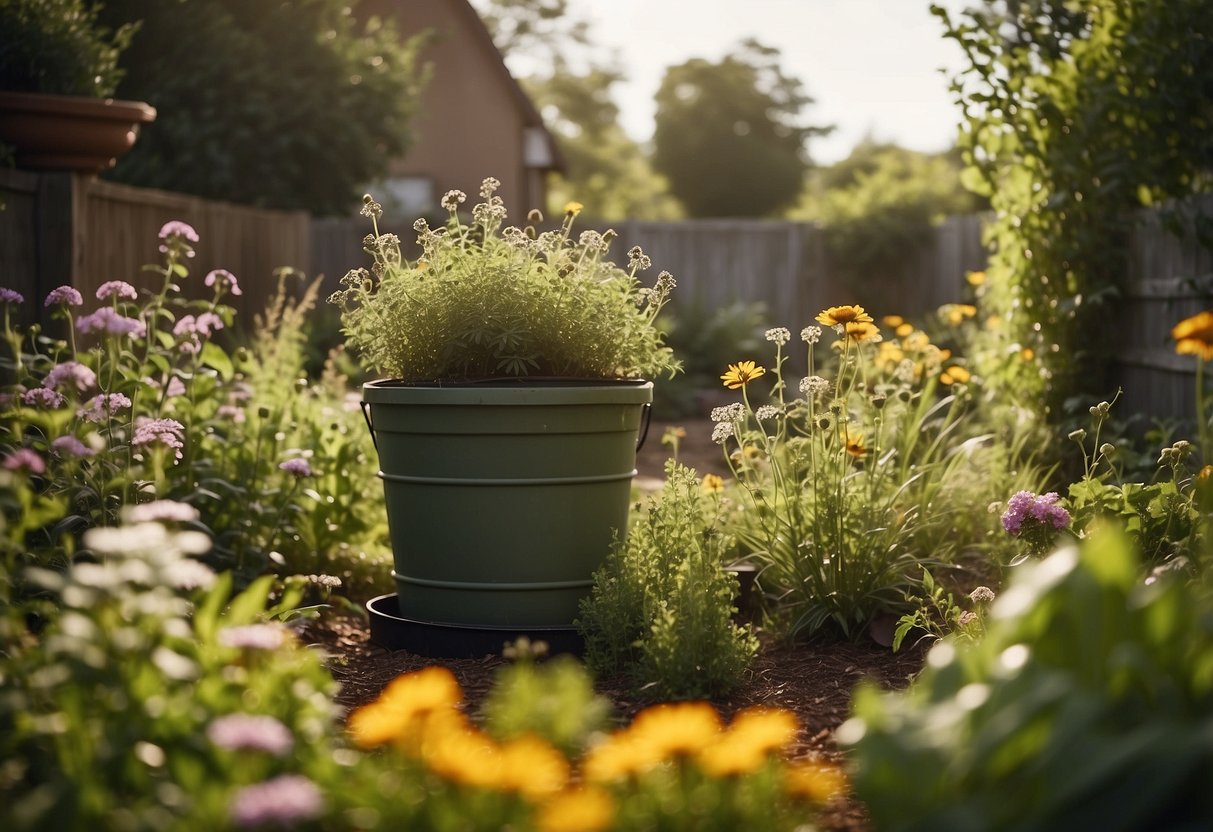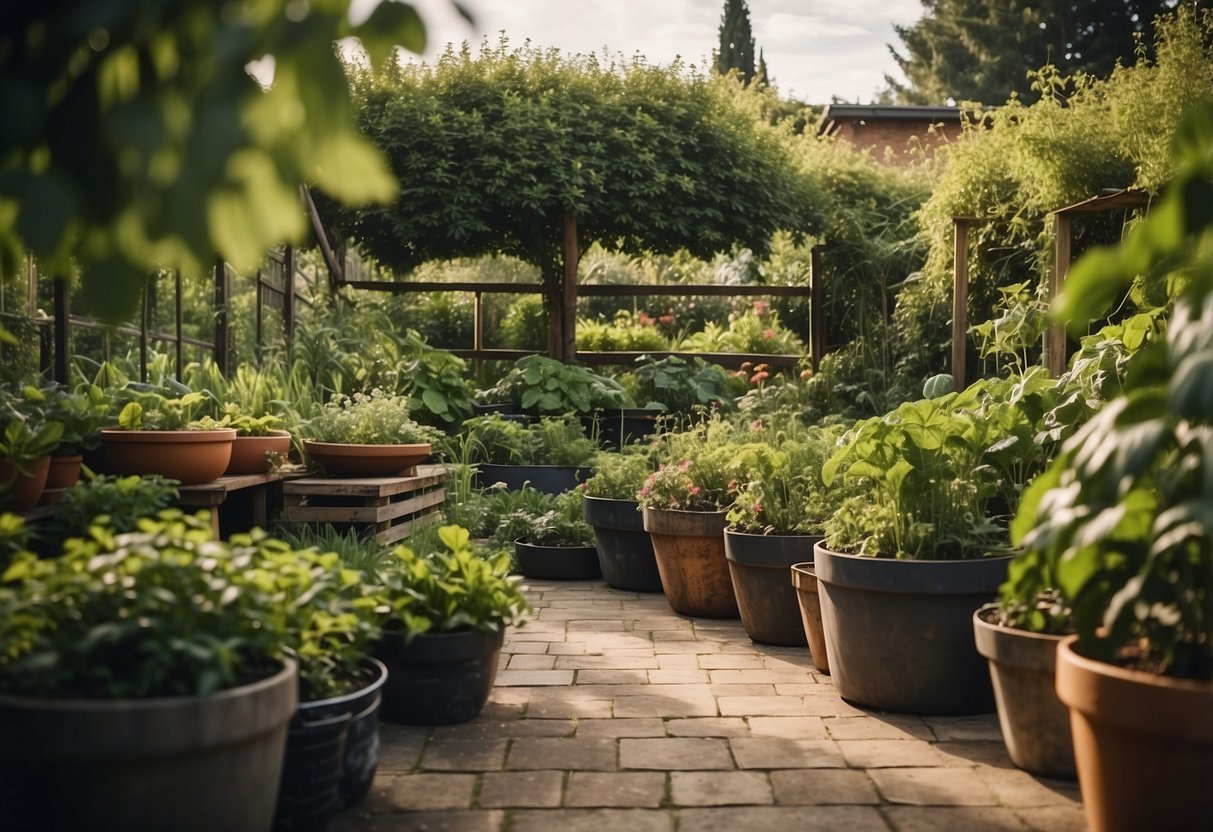Eco Friendly Garden Ideas: Simple Tips for a Greener Yard
Creating an eco-friendly garden is not only good for the environment, but it can also make your outdoor space more beautiful and enjoyable. By focusing on sustainable practices, you can reduce waste, conserve water, and support local wildlife.

What are some simple ways to make your garden more eco-friendly? This guide will help you explore various methods and ideas to transform your garden into a green oasis. Whether you’re a seasoned gardener or just starting out, you’ll find practical tips to suit your needs and preferences.
1) Companion Planting

Companion planting is a great way to help your garden thrive. By placing certain plants next to each other, you can boost growth and repel pests.
For example, planting marigolds with tomatoes can keep harmful insects away. Another good combo is beans and corn. Beans add nitrogen to the soil, helping the corn grow tall and strong.
Also, some aromatic herbs like basil can keep pests from munching on your veggies. Using companion planting can make your garden healthier and more eco-friendly.
2) Rainwater Harvesting

Rainwater harvesting is a fantastic way to save water in your garden. By collecting rainwater, you reduce your reliance on municipal water.
You can do this by setting up a simple barrel system. When it rains, water flows from your roof into the barrel. This water can be used for watering plants.
For a more advanced setup, consider a wet system. This collects and stores more water, useful for larger gardens. By using stored rainwater, you also minimize stormwater run-off, which helps the environment. Learn about different methods from Homes & Gardens.
3) Native Plants

Native plants are a great choice for an eco-friendly garden. They are naturally adapted to your area’s soil, climate, and pests, which means they need less water and fewer chemicals.
You can help local wildlife by planting native species. Birds, bees, and butterflies are more likely to visit your garden.
Using native plants can also reduce maintenance. Because they’re suited to your region, they tend to thrive with minimal care. Explore options for native plant designs on the Wild Ones website.
4) Composting

Composting is a simple way to make your garden more eco-friendly. Start by choosing a spot for a compost bin or pile. You can use kitchen scraps like vegetable peels and coffee grounds, along with yard waste such as dry leaves and grass clippings.
Layer these materials to help them break down faster. Mixing compost into the soil can enrich it with nutrients and improve its structure. For more tips, check out these sustainable garden ideas.
Regularly turning the compost helps it decompose more quickly. Happy composting!
5) Raised Beds

Raised beds are a fantastic way to grow your garden sustainably. They help with soil drainage and make it easier for you to manage your plants.
Using materials like Aluzinc steel for the beds can ensure they last longer and stay non-toxic. This type of steel does not break down easily and is coated with a food-safe paint.
For the best results, you can incorporate mulch around your plants. Options for mulch include organic grass clippings, leaves, or straw. These help keep moisture in and add organic matter to your soil.
Incorporate compost-rich soil into your raised beds for healthy plant growth. This can support a variety of plants like carrots, rhubarb, and sweet potatoes.
6) Solar Garden Lights

Solar garden lights are a great way to brighten up your outdoor space without harming the environment. They use energy from the sun to power themselves, which means no need for extra electricity.
You can find various options, from string lights for a cozy look to pathway lights for added safety.
Solar lights are easy to install and come in many designs to fit any garden style. They are a perfect eco-friendly choice for lighting up your evenings.
7) Pollinator Gardens

Creating a pollinator garden is a great way to help bees, butterflies, and birds. To attract these important creatures, choose a mix of native plants that bloom from spring to fall. These provide nectar all season long.
Leave parts of your lawn unmowed to make a habitat for insects. Small spikes of purple flowers, like blue vervain, are perfect for drawing in a variety of pollinators. You can also plant butterfly bushes and hydrangeas closer to your home for a beautiful, functional garden. Use hand mowers when possible to be more eco-friendly.
8) Heritage Vegetable Varieties

When considering heritage vegetable varieties for your garden, think about planting heirloom tomatoes. These tomatoes come in various colors and flavors that you won’t find in typical grocery stores.
Another great choice is heritage carrots. They come in a range of colors, from deep purple to bright yellow, and add a fun twist to your garden.
Don’t forget about heritage beans. Varieties like ‘Trail of Tears’ and ‘Dragon’s Tongue’ offer unique looks and tastes. These vegetables not only enhance your garden but also help preserve biodiversity.
9) Organic Pest Control

Keeping your garden free of pests can be done without harmful chemicals.
You can make a simple garlic and pepper spray using a bulb of garlic, a hot pepper, and water. This mix repels many insects.
Another option is to use dish soap. Combine 2 tablespoons of vegetable oil, 2 tablespoons of dish soap, and 4 cups of water. This solution works well against common garden bugs like aphids and whiteflies.
10) Vertical Gardens

Vertical gardens are perfect if you’re short on space. You can add planters to a wall or fence to create a lush, green wall. This not only saves space but also makes your garden look stylish.
Consider using pallet garden walls or hanging plant displays. These options are ideal for urban gardeners looking to maximize their space. Vertical gardens can even help you save water by reducing evaporation.
Try building a vertical garden with terracotta pots or stacked boxes. These designs are not only functional but also add charm to your space. Give your garden a unique touch with these creative ideas.
Benefits Of An Eco Friendly Garden

Creating an eco-friendly garden offers many benefits, from reducing your environmental footprint to supporting local wildlife. These gardens often use less water and help improve the ecosystem around your home.
Reduced Environmental Impact
Eco-friendly gardens help reduce the negative effects on the environment. By using sustainable practices like composting, you cut down on waste sent to landfills. Composting also enriches the soil, reducing the need for chemical fertilizers.
Using native plants lowers maintenance needs. These plants are well-suited to your local climate and soil, which means they require fewer resources.
Eco-friendly gardening also encourages reduced use of pesticides and herbicides. This is better for the environment and safer for you and your family, as it lowers your exposure to harmful chemicals.
Water Conservation
Water conservation is a key benefit of an eco-friendly garden. Collecting rainwater in large containers, known as rain barrels, helps you use less tap water. This not only saves money but also reduces demand on local water supplies.
Planting drought-tolerant species can also make a big difference. These plants require less water and are better adapted for dry conditions. Succulents, lavender, and certain types of ornamental grasses are great choices.
Using mulch in your garden beds helps keep the soil moist. Mulch reduces the need for frequent watering by slowing down evaporation. This can make a significant impact during hot, dry spells.
Improving Biodiversity
Improving biodiversity is another major benefit of eco-friendly gardening. Diverse gardens attract a wide range of birds, insects, and other wildlife. This helps create a balanced ecosystem.
Planting a mix of flowers, shrubs, and trees can provide habitats for various creatures. Pollinators like bees and butterflies are essential for the health of many plants. Including plants that bloom at different times ensures these pollinators have food throughout the growing season.
Companion planting is another great strategy. This involves growing plants together that benefit each other, which can naturally reduce pests without relying on harmful chemicals. For example, marigolds can help deter pests from your vegetable garden.
Sustainable Gardening Practices

To create an eco-friendly garden, you should focus on composting and mulching, organic pest control, and using native plants. These practices help maintain a healthy garden while reducing your environmental impact.
Composting and Mulching
Composting turns kitchen scraps and yard waste into nutrient-rich soil. Start a compost heap with items like fruit peels, vegetable scraps, and coffee grounds. Avoid adding meat or dairy products. Turn the compost regularly to help it decompose faster.
Mulching helps retain moisture in the soil and reduces the need for frequent watering. Use organic mulch like straw, grass clippings, or wood chips. Mulch also suppresses weeds and provides essential nutrients as it breaks down.
Both composting and mulching enrich your garden soil and reduce waste.
Organic Pest Control
Organic pest control uses natural methods to manage garden pests. Instead of chemicals, use beneficial insects like ladybugs and praying mantises that eat harmful pests. You can also plant companion plants that repel unwanted insects. For example, marigolds deter aphids and nematodes.
Create homemade sprays using natural ingredients. A mixture of water, garlic, and soap can keep insects away. Always test homemade sprays on a small part of the plant first.
Regularly inspect your plants for signs of pests. Removing affected leaves or using natural predators helps keep your garden healthy.
Using Native Plants
Planting native species is beneficial for sustainable gardening. Native plants are adapted to your local climate and soil, requiring less water and maintenance. They also support local wildlife by providing food and habitat.
Research which plants are native to your area. Examples include coneflowers, black-eyed Susans, and milkweed in many regions. Native plants often have deep root systems, which help prevent soil erosion and improve water absorption.
Using native plants reduces the need for chemical fertilizers and pesticides, making your garden more eco-friendly and resilient.
Innovative Eco Friendly Garden Ideas

By catching rainwater and growing plants vertically, you can make your garden more sustainable and space-efficient.
Rainwater Harvesting
Rainwater harvesting is a key technique. It involves collecting and storing rainwater for garden use. You can start by setting up rain barrels under your roof’s downspouts. This simple system captures water, reducing your dependence on tap water.
Materials Needed:
- Rain barrel or large container
- Gutter/downspout diverter
- Fine mesh screen (to keep debris out)
Steps to Set Up:
- Place the barrel under a downspout.
- Install the diverter to channel water into the barrel.
- Use the mesh screen to prevent leaves and pests from contaminating the water.
This method helps conserve water and can lower your water bill.
Vertical Gardening
Vertical gardening makes the most of limited space. It involves growing plants upward on structures like trellises, walls, or specially designed planters.
Benefits include:
- Space Efficiency: Perfect for small yards or patios.
- Improved Air Circulation: Reduces plant diseases.
- Easier Maintenance: Easier access to plants for watering and harvesting.
Plants to Try:
- Climbing vegetables: beans, peas
- Vines: ivy, grapes
- Flowers: morning glories, clematis
Steps to Create a Vertical Garden:
- Choose a sunny wall or install a sturdy trellis.
- Select suitable plants and plant them in containers at the base.
- Guide the plants to grow upwards with ties or clips.
Using vertical gardening, you can increase your planting area and boost your garden’s productivity.







